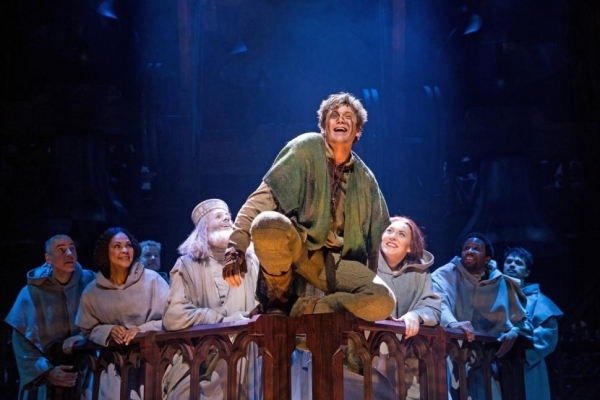
Hunchback of Notre Dame. Music & lyrics by Alan Menken & Stephen Schwartz. Paper Mill Playhouse, 2015.
*
Another Disney cartoon film is aiming for Broadway. But this adaptation eschews cuteness in favor of medieval darkness, and its score is more choral and symphonic than you might expect.
This is due to the desires of two musical titans, Stephen Schwartz (who wrote words and music for Wicked and Pippin) and Alan Menken (who composed Beauty and the Beast and The Little Mermaid). Each of them wanted to create a more substantial piece than the animated film and they enlisted a writer with an activist political past, Peter Parnell (“The West Wing”) to write a new book.
The result is not the kid-friendly fare that we expect from the Mickey factory. The story has a sadder ending and Menken and Schwartz added many more songs to the score they wrote for the animated film, creating a major new work. The script returns more to Victor Hugo’s original story, and virtually all the lyrics are new, as is much of the music.
More emphasis is given to a religious and political leader who leads a movement to cleanse Paris of foreigners. He is the Archdeacon Frollo (Patrick Page) who would like to incarcerate or deport gypsies, saying they are responsible for a high crime rate and they put a burden on governmental and church institutions. How’s that for contemporary relevance?
As with Les Miserables, this show is based on a Victor Hugo novel, borrowing that show’s locale and self-righteous zealot and melding it with sympathy for an ugly, misunderstood man like The Phantom of the Opera. Stephen Schwartz observed: “I write a lot of shows with outcasts in the lead. Think of Elphaba in Wicked.” In fact, Schwartz penned a power ballad “God Help the Outcasts.”
Quasimodo (the very appealing Michael Arden) is a deformed young man who is employed as the bell ringer at the Cathedral of Notre Dame in 1482 Paris. He lives in lonely isolation, ashamed of his physical handicap, and is kept under the thumb of his uncle the archdeacon. His only companions are the bells and the statues of gargoyles, angels and saints surrounding him.
Archdeacon Frollo is a more dimensional character here than in the movie where he is identified as a judge rather than a religious leader. Frollo restricts Quasimodo to the bell tower because he thinks he knows how this deformed creature will be treated by a world that does not tolerate difference. Quasimodo sneaks down to the streets of Paris where he meets the gypsy Esmerelda (Ciara Renae) and falls in love with her. A complication — the captain of the cathedral guard (Andrew Samonsky) is also in love with Esmerelda and the sexually-obsessed archdeacon inappropriately lusts for her too.
The set for Hunchback is impressive. We appear to be inside the Notre Dame cathedral, illuminated with reflections from stained glass windows. A choir fills the pews of the church, facing the audience, and their chorales play a major role, intoning Latin hymns and commenting on the action. Six enormous bells are visible above. They will descend at key moments to give the impression that the actors are climbing up towards the cathedral’s roof.
The direction is by Stephen Schwartz’s son Scott. He smartly adapted historical period-based theatrical devices such as having Arden smudge his face and put on a hump in our view to become the “monster” and having other players change costumes and adopt new roles in plain sight.
The orchestra is larger than at most musicals these days and displays an almost symphonic lushness as it plays Michael Starobin’s arrangements.
Read other reviews on The Cultural Critic